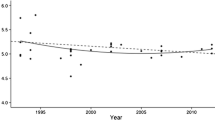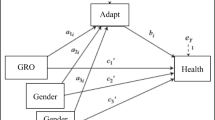Abstract
The Bem Sex-Role Inventory was given to a random sample of 369 middle-class, 20–59-year-old women during the second year of a panel study. A median split on the masculine and feminine scores was used to define feminine (47%), androgynous (24%), masculine (10%), and undifferentiated (19%) women. The four groups were compared using analysis of variance and multiple regression techniques on a variety of demographic, attitudinal, time utilization, personality, and health characteristics to investigate the relationships among sex-typing, attitudes, and behavior. Significant demographic, time utilization, personality, and attitudinal differences were generally consistent with sex-typing, but differences in health were not found.
Similar content being viewed by others
References
Balter, M. D., & Levine, J. Character and extent of psychotropic drug usage in the United States. Paper presented at the Fifth World Congress on Psychiatry, Mexico City, 1971.
Bem, S. L. Psychology looks at the sex-roles: Where have all the androgynous people gone? Paper presented at the University of California at Los Angeles, Symposium on Women, May 1972.
Bem, S. L. The measurement of psychological androgyny. Journal of Consulting and Clinical Psychology, 1974, 42, 155–162.
Bem, S. L. On the utility of alternative procedures for assessing psychological androgyny. Journal of Consulting and Clinical Psychology, 1977, 45, 196–205.
Bem, S. L., Martyna, W., & Watson, C. Sex-typing and androgyny: Further explorations of the expressive domain. Journal of Personality and Social Psychology, 1976, 34, 1016–1023.
Burgess, E., & Locke, H. The family (2nd ed.). New York: American Book, 1960.
Cosentino, F., & Heilbrun, A. B. Anxiety correlates of sex-role identity in college students. Psychological Reports, 1964, 14, 729–730.
Eysenck, H. J., & Eysenck, S. B. G. The Eysenck Personality Inventory. San Diego, California: Educational and Industrial Testing Service; London: University of London Press, 1963.
Featherman, D. Metrics of occupational status reconciled to the 1970 Bureau of Census Classification of Detailed Occupational Titles (based on Census Technical Paper No. 26, “1970 Occupation and Industry Classification Systems in Terms of Their 1960 Occupation and Industry Elements”), 1973. Update of Duncan's socioeconomic status metric described in J. Reiss and others (Eds.), Occupational and social status. New York: Free Press of Glencoe, 1961.
Fidell, L. S. Psychotropic drug use by women: Health, attitudinal, personality, and demographic correlates. Paper presented at the 85th Annual Meeting of the American Psychological Association, San Francisco, California, August 1977.
Fidell, L. S. Employment status, role dissatisfaction, and the housewife syndrome. Psychology of Women Quarterly, in press.
Gaudreau, P. Factor analysis of the Bem Sex-Role Inventory. Journal of Consulting and Clinical Psychology, 1977, 45, 299–302.
Glock, C., Ringer, B., & Babbie, E. To comfort and to challenge. Berkeley: University of California Press, 1967.
Gray, S. W. Masculinity-femininity in relation to anxiety and social acceptance. Child Development, 1957, 28, 203–214.
Gray, S. W. Perceived similarity to parents and adjustment. Child Development, 1959, 30, 91–107.
Hartford, T. C., Willis, C. H., & Deabler, H. L. Personality correlates of masculinity-feminity. Psychological Reports, 1967, 21, 881–884.
Johnson, G. An instrument for the assessment of job satisfaction. Personnel Psychology, 1955, 8, 27–37.
Langner, T. A 22-item screening score of psychiatric symptoms indicating impairment. Journal of Health and Human Behavior, 1962, 3, 269–276.
Locke, H., & Wallace, K. Short marital-adjustment and prediction tests: Their reliability and validity. Marriage and Family Living, 1959, 21, 251–255.
Maccoby, E. E. Sex differences in intellectual functioning. In E. E. Maccoby (Ed.), The development of sex differences. Stanford, California: Stanford University Press, 1966.
Mussen, P. H. Long-term consequences of masculinity of interests in adolescence. Journal of Consulting Psychology, 1962, 26, 435–440.
Rahe, R. H. The pathway between subject's recent life changes and their near-future illness reports: Representative results and methodological issues. In B. S. Dohrenwend and B. P. Dohrenwend (Eds.), Stressful life events: Their nature and effects. New York: Wiley, 1974.
Rollins, B., & Feldman, H. Marital satisfaction over the family life cycle. Journal of Marriage and Family, 1970, 32, 29–38.
Rosenberg, M. Society and the adolescent self-image. Princeton, New Jersey: Princeton University Press, 1965.
Rotter, J. B. Generalized expectancies for internal versus external control of reinforcement. Psychological Monographs, 1966, 80 (1, Whole No. 609).
Sears, R. R. Relation of early socialization experiences to self-concepts and gender role in middle childhood. Child Development, 1970, 41, 267–289.
Spence, J., & Helmreich, R. The attitudes towards women scale: An objective instrument to measure attitudes towards rights and roles of women in contemporary society. Journal Supplementary Abstract Service (Catalogue of Selected Documents in Psychology), 1972, 2, 66.
Spence, J., Helmreich, R., and Stapp, J. Ratings of self and peers on sex-role attributes and their relation to self-esteem and conceptions of masculinity and femininity. Journal of Personality and Social Psychology, 1975, 32, 29–39.
Webb, A. P. Sex-role preferences and adjustment in early adolescents. Child Development, 1963, 34, 609–618.
Wetter, R. E. Levels of self-esteem associated with four sex role categories. Paper presented at the 83rd Annual Meeting of the American Psychological Association, Chicago, Illinois, August 1975.
Author information
Authors and Affiliations
Additional information
Research for this paper was funded by a National Institute of Drug Abuse grant (DA 00847) to L. S. Fidell and J. E. Prather. Correspondence should be addressed to Linda S. Fidell, Department of Psychology, California State University, Northridge, California 91330.
Rights and permissions
About this article
Cite this article
Hoffman, D.M., Fidell, L.S. Characteristics of androgynous, undifferentiated, masculine, and feminine middle-class women. Sex Roles 5, 765–781 (1979). https://doi.org/10.1007/BF00287937
Issue Date:
DOI: https://doi.org/10.1007/BF00287937




